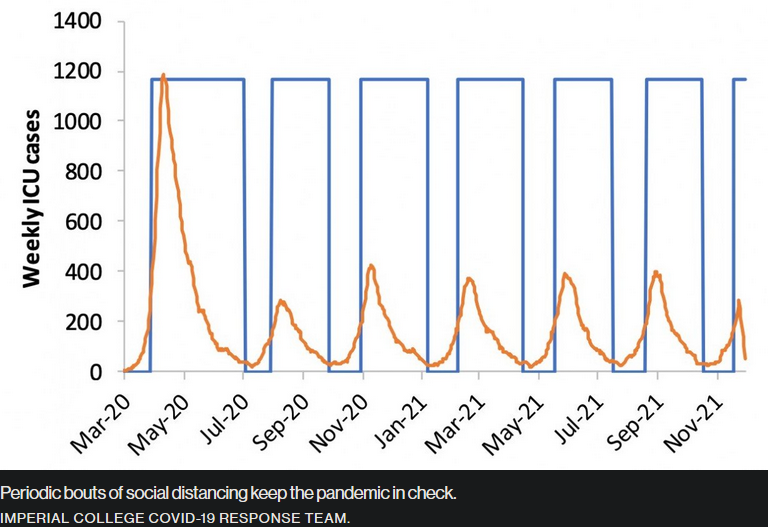
Some optimistic pundits and analysts are hoping for a quick return to normalcy and a rapid recovery in the economy. Don’t bet on it.
Optimism is a good thing to have, but unfounded optimism can be dangerous in the face of a harsh reality. Early attempts to downplay the coronavirus pandemic only led to an increase in preventable deaths, and a lack of preparation in terms of critical supplies like N95 masks, ventilators, and other personal protective equipment.
The current round of optimism says that this will all be over soon, and that stay at home orders with large exceptions will be sufficient to stop the spread. This type of thinking will ultimately be just as dangerous as the kind that told us not to worry about this a month or two months ago.
Current measures are insufficient
Covid-19 is extremely contagious. Extremely.
Without social isolation and reduced travel, each infected individual is likely to infect three additional people.
The only country really claiming to have this under control is China but a) their numbers and data isn’t always trustworthy and b) the methods they’ve implemented to achieve this go well beyond the amount of freedom we’re willing to surrender to government authority.
Westerners returning from China tell stories of government employees telling you when and if you’re allowed to leave for the day to go get supplies. Those lucky enough to leave for an hour or so will be greeted by checkpoints at every block, where nurses and police officers check temperature and look for signs of symptoms. Those suspected of infection are quickly shipped off to fever clinics where they can be observed and tested.
In contrast, only 42 U.S. states have even issued stay at home orders as of April 5, 2020.
Many of those orders are also extremely flimsy. For example, governor DeSantis of Florida has carved out large exceptions for churches and beaches – even threatening to overturn more stringent rules put forth by local mayors and city councils. A total of 14 states are making exceptions for religious services despite the fact that religious gatherings are one of the quickest methods of spreading the infection.
While this type of stay at home order will continue to disrupt the economy, it won’t actually stop the spread. So the idea might be to disrupt things as little as possible, but by dragging it out these half measures will end up with worse consequences than taking the bold action early.
Reducing the peak still means future waves
When and if we do finally implement rules that successfully stop the growth of infection numbers, we’re likely to see additional waves of the virus coming in for the next year or more.
The image at the top of this post comes from the data in UK’s Imperial College study. As you can see, they predict successive waves of infection causing multiple smaller peaks in the number of admitted ICU cases. So they expect that we’ll isolate ourselves for a while, but once we go back outside we’ll start bringing the virus back out with us. It will spread at its rapid rate, and we’ll find ourselves back in lock-down after just a few weeks of “normalcy.”
This model covers infectious waves through November 2021 – that’s right, 18 months from now.
And we’ve heard 18 months in another context, too: it’s about how long we can expect to wait before there’s a vaccine. Until that vaccine is ready, we’re just trying to mitigate the damage.
It’s probably also worth noting that this study is already looking too optimistic to be realistic. The Imperial College researchers had originally expected that cases would be peaking by now – but there’s no sign of that actually on the horizon any time soon. Our initial response has been too slow and too half-hearted, and now we might not see the end of the first peak until well into May.
No normal to return to
Of all the casualties so far, one that is easy to overlook is the death of normal. Whatever we considered to be the status quo six months ago is something that will never be coming back.
Too many things have changed too rapidly. People are becoming accustomed to new ways of doing their work and interacting with the world. They won’t be clamoring to get their hour-long commutes back, and they might not be so enthusiastic about going back to the office now that they’ve learned they can do their job in half the time when they’ve got half the distractions.
Millions of individuals are likely to face some form of financial default or missed debt payments. This will also be a death sentence for tens of thousands of bars, restaurants, and other small businesses that don’t have the liquidity and cash reserves to survive an extended period of reduced sales and demand.
Even 18 months from now – when and if there’s a vaccine – those businesses won’t magically come back and the people who lost their homes won’t magically get them back. The oil industry may not survive this, and they won’t be the type of business where firms suddenly cease to exist.
As it stands, we’ve got a long road to travel, and we don’t know exactly where it’s taking us, but we do now that it’s far from the place we came from.

Leave a Reply